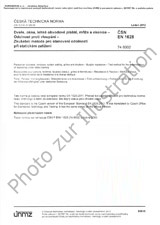Wir benötigen Ihre Einwilligung zur Verwendung der einzelnen Daten, damit Sie unter anderem Informationen zu Ihren Interessen einsehen können. Klicken Sie auf "OK", um Ihre Zustimmung zu erteilen.
ČSN EN 15522-2 (656081)
Oil spill identification - Petroleum and petroleum related products - Part 2: Analytical method and interpretation of results based on GC-FID and GC-low resolution-MS analyses
Name übersetzen
NORM herausgegeben am 1.9.2023
Informationen über die Norm:
Bezeichnung normen: ČSN EN 15522-2
Zeichen: 656081
Katalog-Nummer: 517429
Anmerkung: UNGÜLTIG
Ausgabedatum normen: 1.9.2023
SKU: NS-1152261
Zahl der Seiten: 222
Gewicht ca.: 697 g (1.54 Pfund)
Land: Tschechische technische Norm
Kategorie: Technische Normen ČSN
Normansicht ČSN EN 15522-2 (656081)
Empfehlungen:
Aktualisierung der technischen Normen
Wollen Sie sich sicher sein, dass Sie nur die gültigen technischen Normen verwenden?
Wir bieten Ihnen eine Lösung, die Ihnen eine Monatsübersicht über die Aktualität der von Ihnen angewandten Normen sicher stellt.
Brauchen Sie mehr Informationen? Sehen Sie sich diese Seite an.




 Cookies
Cookies
